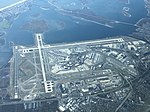TWA Flight 843
1990s in Queens1992 in New York CityAccidents and incidents involving the Lockheed L-1011Airliner accidents and incidents caused by instrument failureAirliner accidents and incidents caused by maintenance errors ... and 8 more
Airliner accidents and incidents caused by mechanical failureAirliner accidents and incidents caused by pilot errorAirliner accidents and incidents in New York CityAviation accidents and incidents in the United States in 1992John F. Kennedy International AirportJuly 1992 events in the United StatesTrans World Airlines accidents and incidentsUse mdy dates from September 2016

TWA Flight 843 (TW843, TWA843) was a scheduled Trans World Airlines passenger flight that crashed after an aborted takeoff from John F. Kennedy International Airport (New York) to San Francisco International Airport (California) in July 1992. Despite an intense fire after the crash, the crew was able to evacuate all 280 passengers from the aircraft. There was no loss of life, though the aircraft was destroyed by the fire.
Excerpt from the Wikipedia article TWA Flight 843 (License: CC BY-SA 3.0, Authors, Images).TWA Flight 843
New York Queens County
Geographical coordinates (GPS) Address Nearby Places Show on map
Geographical coordinates (GPS)
| Latitude | Longitude |
|---|---|
| N 40.628805555556 ° | E -73.771833333333 ° |
Address
Bayswater
11691 New York, Queens County
New York, United States
Open on Google Maps








